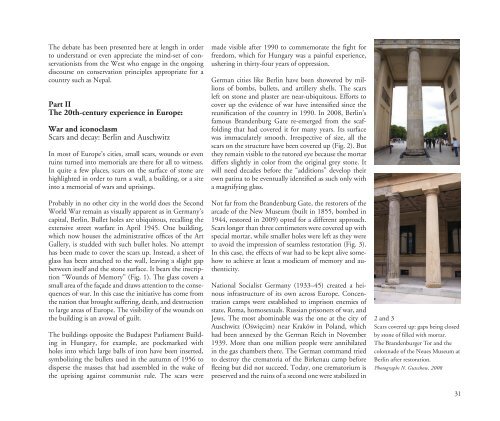KVPT’s Patan Darbar Earthquake Response Campaign - Work to Date - September 2016
Create successful ePaper yourself
Turn your PDF publications into a flip-book with our unique Google optimized e-Paper software.
The debate has been presented here at length in order<br />
<strong>to</strong> understand or even appreciate the mind-set of conservationists<br />
from the West who engage in the ongoing<br />
discourse on conservation principles appropriate for a<br />
country such as Nepal.<br />
Part II<br />
The 20th-century experience in Europe:<br />
War and iconoclasm<br />
Scars and decay: Berlin and Auschwitz<br />
In most of Europe’s cities, small scars, wounds or even<br />
ruins turned in<strong>to</strong> memorials are there for all <strong>to</strong> witness.<br />
In quite a few places, scars on the surface of s<strong>to</strong>ne are<br />
highlighted in order <strong>to</strong> turn a wall, a building, or a site<br />
in<strong>to</strong> a memorial of wars and uprisings.<br />
Probably in no other city in the world does the Second<br />
World War remain as visually apparent as in Germany’s<br />
capital, Berlin. Bullet holes are ubiqui<strong>to</strong>us, recalling the<br />
extensive street warfare in April 1945. One building,<br />
which now houses the administrative offices of the Art<br />
Gallery, is studded with such bullet holes. No attempt<br />
has been made <strong>to</strong> cover the scars up. Instead, a sheet of<br />
glass has been attached <strong>to</strong> the wall, leaving a slight gap<br />
between itself and the s<strong>to</strong>ne surface. It bears the inscription<br />
“Wounds of Memory” (Fig. 1). The glass covers a<br />
small area of the façade and draws attention <strong>to</strong> the consequences<br />
of war. In this case the initiative has come from<br />
the nation that brought suffering, death, and destruction<br />
<strong>to</strong> large areas of Europe. The visibility of the wounds on<br />
the building is an avowal of guilt.<br />
The buildings opposite the Budapest Parliament Building<br />
in Hungary, for example, are pockmarked with<br />
holes in<strong>to</strong> which large balls of iron have been inserted,<br />
symbolizing the bullets used in the autumn of 1956 <strong>to</strong><br />
disperse the masses that had assembled in the wake of<br />
the uprising against communist rule. The scars were<br />
made visible after 1990 <strong>to</strong> commemorate the fight for<br />
freedom, which for Hungary was a painful experience,<br />
ushering in thirty-four years of oppression.<br />
German cities like Berlin have been showered by millions<br />
of bombs, bullets, and artillery shells. The scars<br />
left on s<strong>to</strong>ne and plaster are near-ubiqui<strong>to</strong>us. Efforts <strong>to</strong><br />
cover up the evidence of war have intensified since the<br />
reunification of the country in 1990. In 2008, Berlin’s<br />
famous Brandenburg Gate re-emerged from the scaffolding<br />
that had covered it for many years. Its surface<br />
was immaculately smooth. Irrespective of size, all the<br />
scars on the structure have been covered up (Fig. 2). But<br />
they remain visible <strong>to</strong> the tu<strong>to</strong>red eye because the mortar<br />
differs slightly in color from the original grey s<strong>to</strong>ne. It<br />
will need decades before the “additions” develop their<br />
own patina <strong>to</strong> be eventually identified as such only with<br />
a magnifying glass.<br />
Not far from the Brandenburg Gate, the res<strong>to</strong>rers of the<br />
arcade of the New Museum (built in 1855, bombed in<br />
1944, res<strong>to</strong>red in 2009) opted for a different approach.<br />
Scars longer than three centimeters were covered up with<br />
special mortar, while smaller holes were left as they were<br />
<strong>to</strong> avoid the impression of seamless res<strong>to</strong>ration (Fig. 3).<br />
In this case, the effects of war had <strong>to</strong> be kept alive somehow<br />
<strong>to</strong> achieve at least a modicum of memory and authenticity.<br />
National Socialist Germany (1933–45) created a heinous<br />
infrastructure of its own across Europe. Concentration<br />
camps were established <strong>to</strong> imprison enemies of<br />
state, Roma, homosexuals. Russian prisoners of war, and<br />
Jews. The most abominable was the one at the city of<br />
Auschwitz (Oświęcim) near Kraków in Poland, which<br />
had been annexed by the German Reich in November<br />
1939. More than one million people were annihilated<br />
in the gas chambers there. The German command tried<br />
<strong>to</strong> destroy the crema<strong>to</strong>ria of the Birkenau camp before<br />
fleeing but did not succeed. Today, one crema<strong>to</strong>rium is<br />
preserved and the ruins of a second one were stabilized in<br />
2 and 3<br />
Scars covered up: gaps being closed<br />
by s<strong>to</strong>ne of filled with mortar.<br />
The Brandenburger Tor and the<br />
colonnade of the Neues Museum at<br />
Berlin after res<strong>to</strong>ration.<br />
Pho<strong>to</strong>graphs N. Gutschow, 2008<br />
31




